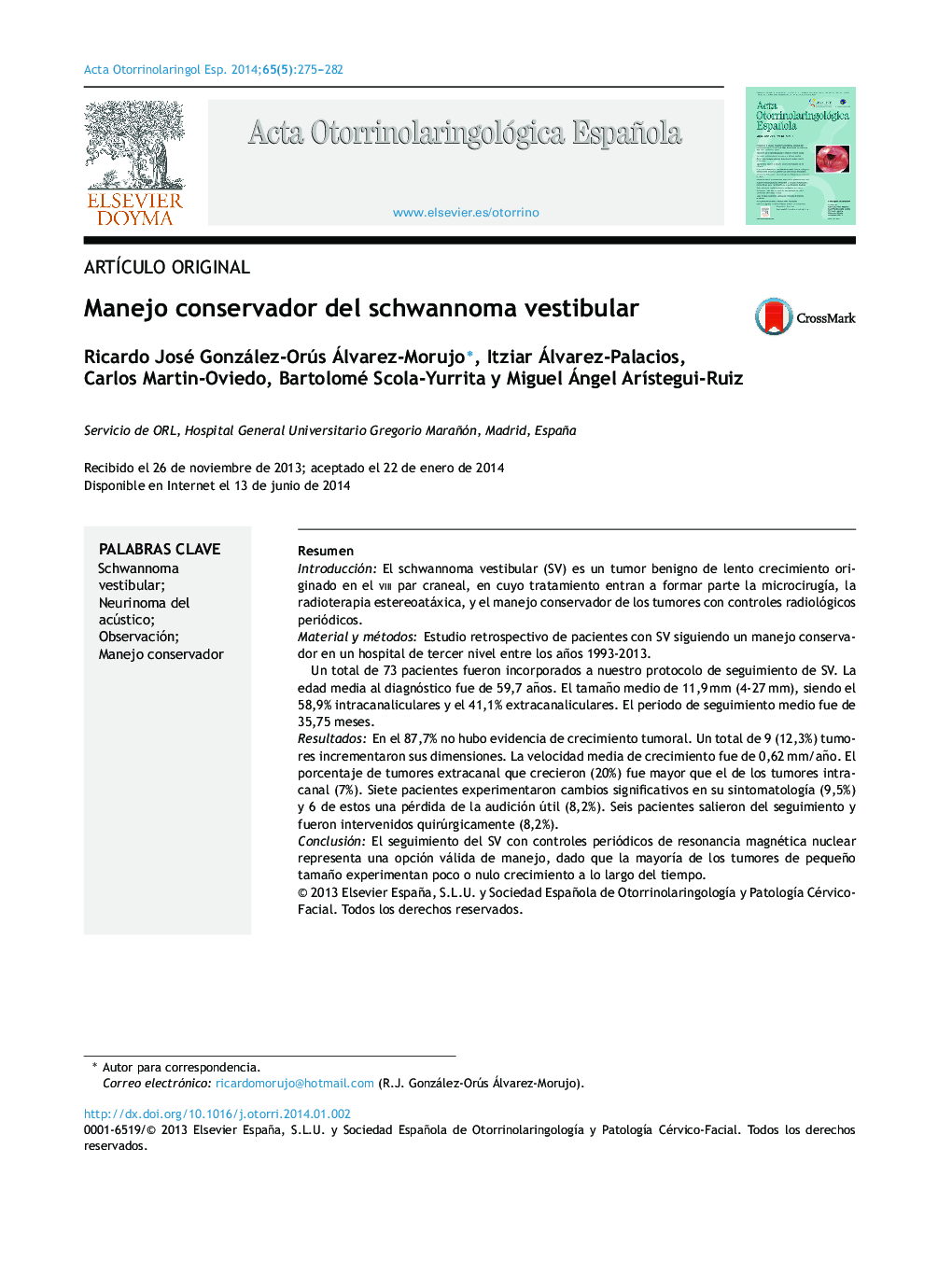| کد مقاله | کد نشریه | سال انتشار | مقاله انگلیسی | نسخه تمام متن |
|---|---|---|---|---|
| 4101867 | 1268794 | 2014 | 8 صفحه PDF | دانلود رایگان |
ResumenIntroducciónEl schwannoma vestibular (SV) es un tumor benigno de lento crecimiento originado en el VIII par craneal, en cuyo tratamiento entran a formar parte la microcirugía, la radioterapia estereoatáxica, y el manejo conservador de los tumores con controles radiológicos periódicos.Material y métodosEstudio retrospectivo de pacientes con SV siguiendo un manejo conservador en un hospital de tercer nivel entre los años 1993-2013.Un total de 73 pacientes fueron incorporados a nuestro protocolo de seguimiento de SV. La edad media al diagnóstico fue de 59,7 años. El tamaño medio de 11,9 mm (4-27 mm), siendo el 58,9% intracanaliculares y el 41,1% extracanaliculares. El periodo de seguimiento medio fue de 35,75 meses.ResultadosEn el 87,7% no hubo evidencia de crecimiento tumoral. Un total de 9 (12,3%) tumores incrementaron sus dimensiones. La velocidad media de crecimiento fue de 0,62 mm/año. El porcentaje de tumores extracanal que crecieron (20%) fue mayor que el de los tumores intracanal (7%). Siete pacientes experimentaron cambios significativos en su sintomatología (9,5%) y 6 de estos una pérdida de la audición útil (8,2%). Seis pacientes salieron del seguimiento y fueron intervenidos quirúrgicamente (8,2%).ConclusiónEl seguimiento del SV con controles periódicos de resonancia magnética nuclear representa una opción válida de manejo, dado que la mayoría de los tumores de pequeño tamaño experimentan poco o nulo crecimiento a lo largo del tiempo.
IntroductionVestibular schwannoma (VS) is a benign, slow-growing tumour originating in the 8 th cranial nerve. The treatment includes microsurgery, stereotactic radiotherapy and conservative management of tumours with periodic radiological tests.MethodsThis was a retrospective study of patients with VS following conservative management in a tertiary hospital between 1993 and 2013. A total of 73 patients were enrolled in our protocol. The mean age at diagnosis was 59.7 years. The average size was 11.9 mm (4-27 mm); 58.9% of the tumours were intracanalicular and 41.1%, extracanalicular. The mean follow-up period was 35.75 months.ResultsIn 87.7% of patients there was no evidence of tumour growth. A total of 9 tumours (12.3%) increased in size. The average growth rate was 0.62 mm/year. The percentage of extracanalicular tumours that grew (20%) was higher than that of intracanalicular tumours (7%). Seven patients (9.5%) experienced significant changes in their symptoms and 6 of these (8.2%) experienced a loss of useful hearing. Six patients (8.2%) left follow-up and underwent surgery.ConclusionsPeriodic monitoring of vestibular schwannomas with magnetic resonance imaging represents an option for management, because most small tumours experience little or no growth over time.
Journal: Acta Otorrinolaringológica Española - Volume 65, Issue 5, September–October 2014, Pages 275–282
